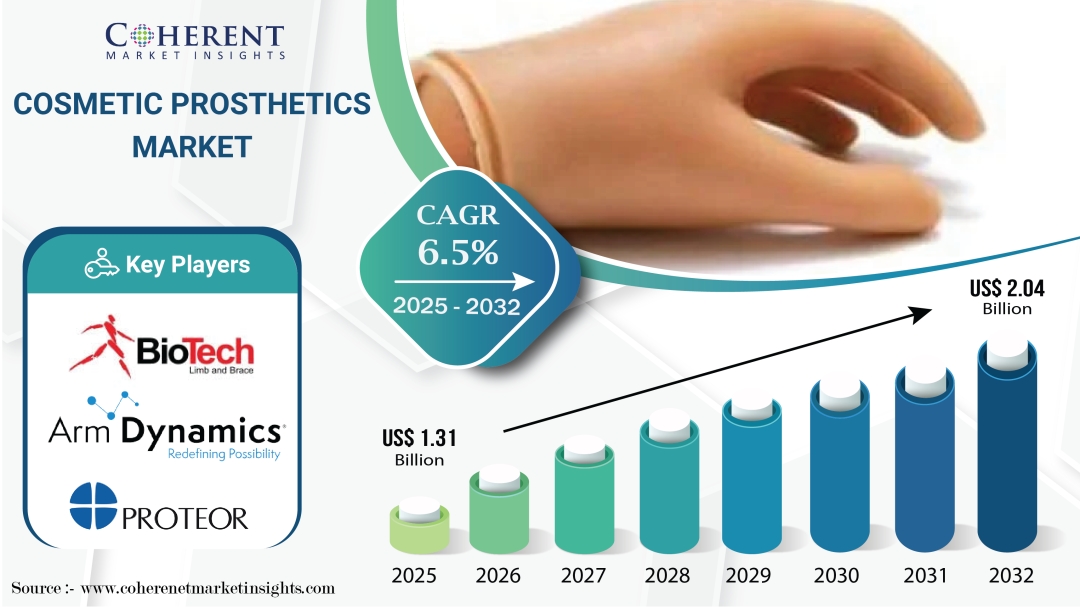The Cosmetic Prosthetics Market is estimated to be valued at USD 1.31 Bn in 2025 and is expected to reach USD 2.04 Bn by 2032, exhibiting a compound annual growth rate (CAGR) of 6.5% from 2025 to 2032. Advancements in material science and 3D printing are transforming the cosmetic prosthetics industry, enabling the creation of devices that are more realistic, comfortable, and personalized than ever before. New-generation materials that replicate the texture, flexibility, and resilience of human skin allow prosthetics to blend seamlessly with natural features. The integration of 3D scanning and printing ensures precise customization to individual shapes and sizes, while cutting-edge software supports enhanced design, digital mapping, and accurate color matching for superior aesthetic outcomes.
Request a Sample Copy of this Report at: https://www.coherentmarketinsights.com/insight/request-sample/6748
Global Cosmetic Prosthetics Market Key Takeaways
According to Coherent Market Insights (CMI), the global cosmetic prosthetics market size is projected to reach USD 1.31 Bn in 2025 and further expand at a CAGR of 6.5% during the forecast period, totaling USD 2.04 Bn by 2032.
Silicone is the most widely used material for making cosmetic prosthetics, accounting for a market share of 46.3% in 2025.
Upper limb prosthetics are expected to remain the top-selling products, accounting for nearly two-fifths of the global cosmetic prosthetics market share in 2025.
Prosthetic clinics, with an estimated market share of 46.4% in 2025, are set to remain leading end users of cosmetic prosthetics.
North America is set to dominate the global cosmetic prosthetics industry, holding a market share of 42.4% by 2025.
Asia Pacific is slated to emerge as a hotbed for cosmetic prosthetics companies during the forecast period.
Rising Incidence of Trauma and Congenital Disorders Propelling Market Growth
Coherent Market Insights’ latest cosmetic prosthetics market research report lists significant factors driving industry growth. One such prominent growth driver is the increasing incidence of trauma and congenital disorders.
There is a rise in road accidents, industrial injuries, and war-related traumas globally, all of which contribute to a growing number of amputations. This, in turn, is fueling demand for cosmetic prosthetics, especially facial and limb prosthetics.
Similarly, the prevalence of birth defects and disease-related amputations is increasing across nations like the United States and India. The U.S. Centers for Disease Control and Prevention (CDC) reports that about 1 in every 2,100 babies in the United States is born with a limb reduction defect. This trend is expected to further boost demand for cosmetic prosthetics in the coming years.
High Cost of Cosmetic Prosthetics Hampering Market Growth
The future cosmetic prosthetics market outlook looks promising, owing to rising prevalence of congenital deformities and increasing incidence of road accidents. However, high cost of cosmetic prosthetic products presents a significant barrier to widespread market expansion.
Advanced cosmetic prosthetics are often expensive because of the use of advanced materials, personalized design requirements, and integration of sophisticated technologies. This cost burden limits access for patients, especially in low and middle-income nations, potentially dampening overall cosmetic prosthetics market demand.
Media Contact
Company Name: Coherent Market Insights
Contact Person: Mr. Shah
Email:Send Email
Phone: + 12524771362
Address:533 Airport Boulevard, Suite 400, Burlingame, CA 94010, United States
City: Burlingame, CA 94010
State: California
Country: United States
Website: https://www.coherentmarketinsights.com/industry-reports/cosmetic-prosthetics-market

